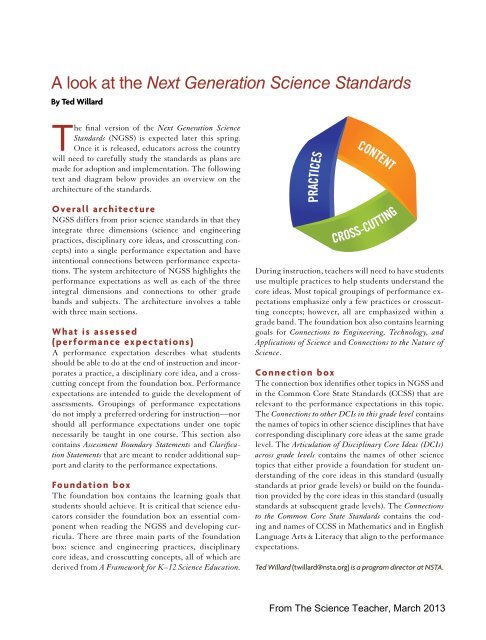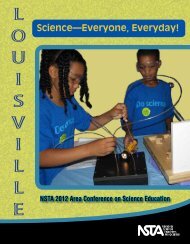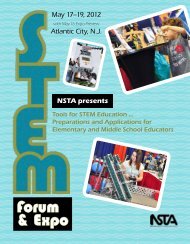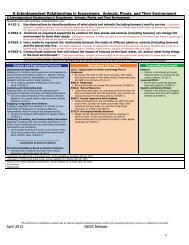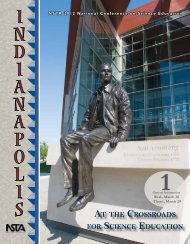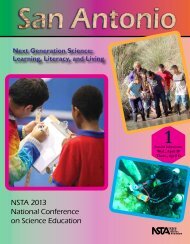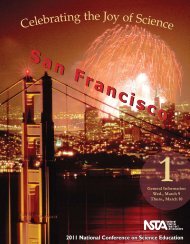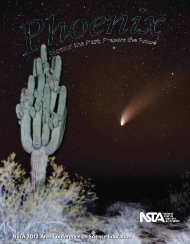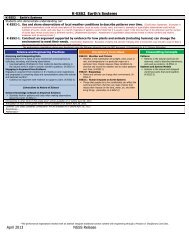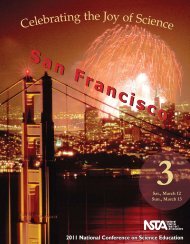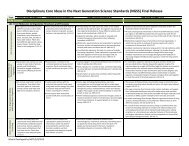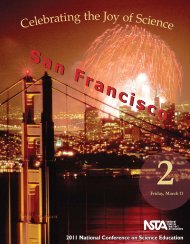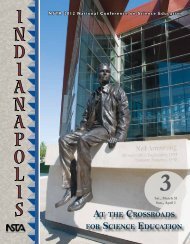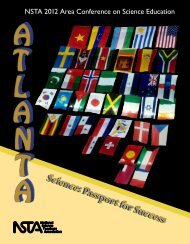A look at the Next Generation Science Standards
A look at the Next Generation Science Standards
A look at the Next Generation Science Standards
Create successful ePaper yourself
Turn your PDF publications into a flip-book with our unique Google optimized e-Paper software.
A <strong>look</strong> <strong>at</strong> <strong>the</strong> <strong>Next</strong> Gener<strong>at</strong>ion <strong>Science</strong> <strong>Standards</strong>By Ted WillardThe final version of <strong>the</strong> <strong>Next</strong> Gener<strong>at</strong>ion <strong>Science</strong><strong>Standards</strong> (NGSS) is expected l<strong>at</strong>er this spring.Once it is released, educ<strong>at</strong>ors across <strong>the</strong> countrywill need to carefully study <strong>the</strong> standards as plans aremade for adoption and implement<strong>at</strong>ion. The followingtext and diagram below provides an overview on <strong>the</strong>architecture of <strong>the</strong> standards.Overall architectureNGSS differs from prior science standards in th<strong>at</strong> <strong>the</strong>yintegr<strong>at</strong>e three dimensions (science and engineeringpractices, disciplinary core ideas, and crosscutting concepts)into a single performance expect<strong>at</strong>ion and haveintentional connections between performance expect<strong>at</strong>ions.The system architecture of NGSS highlights <strong>the</strong>performance expect<strong>at</strong>ions as well as each of <strong>the</strong> threeintegral dimensions and connections to o<strong>the</strong>r gradebands and subjects. The architecture involves a tablewith three main sections.Wh<strong>at</strong> is assessed(performance expect<strong>at</strong>ions)A performance expect<strong>at</strong>ion describes wh<strong>at</strong> studentsshould be able to do <strong>at</strong> <strong>the</strong> end of instruction and incorpor<strong>at</strong>esa practice, a disciplinary core idea, and a crosscuttingconcept from <strong>the</strong> found<strong>at</strong>ion box. Performanceexpect<strong>at</strong>ions are intended to guide <strong>the</strong> development ofassessments. Groupings of performance expect<strong>at</strong>ionsdo not imply a preferred ordering for instruction—norshould all performance expect<strong>at</strong>ions under one topicnecessarily be taught in one course. This section alsocontains Assessment Boundary St<strong>at</strong>ements and Clarific<strong>at</strong>ionSt<strong>at</strong>ements th<strong>at</strong> are meant to render additional supportand clarity to <strong>the</strong> performance expect<strong>at</strong>ions.Found<strong>at</strong>ion boxThe found<strong>at</strong>ion box contains <strong>the</strong> learning goals th<strong>at</strong>students should achieve. It is critical th<strong>at</strong> science educ<strong>at</strong>orsconsider <strong>the</strong> found<strong>at</strong>ion box an essential componentwhen reading <strong>the</strong> NGSS and developing curricula.There are three main parts of <strong>the</strong> found<strong>at</strong>ionbox: science and engineering practices, disciplinarycore ideas, and crosscutting concepts, all of which arederived from A Framework for K–12 <strong>Science</strong> Educ<strong>at</strong>ion.During instruction, teachers will need to have studentsuse multiple practices to help students understand <strong>the</strong>core ideas. Most topical groupings of performance expect<strong>at</strong>ionsemphasize only a few practices or crosscuttingconcepts; however, all are emphasized within agrade band. The found<strong>at</strong>ion box also contains learninggoals for Connections to Engineering, Technology, andApplic<strong>at</strong>ions of <strong>Science</strong> and Connections to <strong>the</strong> N<strong>at</strong>ure of<strong>Science</strong>.Connection boxThe connection box identifies o<strong>the</strong>r topics in NGSS andin <strong>the</strong> Common Core St<strong>at</strong>e <strong>Standards</strong> (CCSS) th<strong>at</strong> arerelevant to <strong>the</strong> performance expect<strong>at</strong>ions in this topic.The Connections to o<strong>the</strong>r DCIs in this grade level contains<strong>the</strong> names of topics in o<strong>the</strong>r science disciplines th<strong>at</strong> havecorresponding disciplinary core ideas <strong>at</strong> <strong>the</strong> same gradelevel. The Articul<strong>at</strong>ion of Disciplinary Core Ideas (DCIs)across grade levels contains <strong>the</strong> names of o<strong>the</strong>r sciencetopics th<strong>at</strong> ei<strong>the</strong>r provide a found<strong>at</strong>ion for student understandingof <strong>the</strong> core ideas in this standard (usuallystandards <strong>at</strong> prior grade levels) or build on <strong>the</strong> found<strong>at</strong>ionprovided by <strong>the</strong> core ideas in this standard (usuallystandards <strong>at</strong> subsequent grade levels). The Connectionsto <strong>the</strong> Common Core St<strong>at</strong>e <strong>Standards</strong> contains <strong>the</strong> codingand names of CCSS in M<strong>at</strong>hem<strong>at</strong>ics and in EnglishLanguage Arts & Literacy th<strong>at</strong> align to <strong>the</strong> performanceexpect<strong>at</strong>ions.Ted Willard (twillard@nsta.org) is a program director <strong>at</strong> NSTA.
Inside <strong>the</strong>NGSS BoxWh<strong>at</strong> is AssessedA collection of severalperformance expect<strong>at</strong>ionsdescribing wh<strong>at</strong> studentsshould be able to do to masterthis standard.Found<strong>at</strong>ion BoxThe practices, core disciplinaryideas, and crosscuttingconcepts from A Frameworkfor K–12 <strong>Science</strong> Educ<strong>at</strong>ionth<strong>at</strong> were used to form <strong>the</strong>performance expect<strong>at</strong>ions.Connection BoxO<strong>the</strong>r standards in <strong>the</strong> <strong>Next</strong>Gener<strong>at</strong>ion <strong>Science</strong> <strong>Standards</strong>or in <strong>the</strong> Common Core St<strong>at</strong>e<strong>Standards</strong> th<strong>at</strong> are rel<strong>at</strong>edto this standard.Based on <strong>the</strong>January 2013Draft of NGSSTitle and CodeThe titles of standard pages are not necessarily unique and may bereused <strong>at</strong> several different grade levels. The code, however, is aunique identifier for each set based on <strong>the</strong> grade level, contentarea, and topic it addresses.Codes for Performance Expect<strong>at</strong>ionsCodes design<strong>at</strong>e <strong>the</strong> relevant performance expect<strong>at</strong>ion for an item in <strong>the</strong>found<strong>at</strong>ion box and connection box. In <strong>the</strong> connections to common core, italicsindic<strong>at</strong>e a potential connection r<strong>at</strong>her than a required prerequisite connection.Performance Expect<strong>at</strong>ionsA st<strong>at</strong>ement th<strong>at</strong> combines practices, core ideas,and crosscutting concepts toge<strong>the</strong>r to describehow students can show wh<strong>at</strong> <strong>the</strong>y have learned.Clarific<strong>at</strong>ion St<strong>at</strong>ementA st<strong>at</strong>ement th<strong>at</strong> supplies examples or additionalclarific<strong>at</strong>ion to <strong>the</strong> performance expect<strong>at</strong>ion.Assessment BoundaryA st<strong>at</strong>ement th<strong>at</strong> provides guidance about <strong>the</strong>scope of <strong>the</strong> performance expect<strong>at</strong>ion <strong>at</strong> aparticular grade level.Engineering Connection (*)An asterisk indic<strong>at</strong>es an engineering connectionin <strong>the</strong> practice, core idea, or crosscutting conceptth<strong>at</strong> supports <strong>the</strong> performance expect<strong>at</strong>ion.Scientific and Engineering PracticesActivities th<strong>at</strong> scientists and engineers engage into ei<strong>the</strong>r understand <strong>the</strong> world or solve aproblem.Disciplinary Core IdeasConcepts in science and engineering th<strong>at</strong> havebroad importance within and across disciplinesas well as relevance to people’s lives.Crosscutting ConceptsIdeas, such as P<strong>at</strong>terns and Cause and Effect,which are not specific to any one discipline butcut across <strong>the</strong>m all.Connections to Engineering, Technology,and Applic<strong>at</strong>ions of <strong>Science</strong>These connections are drawn from <strong>the</strong> disciplinarycore ideas for engineering, technology, andapplic<strong>at</strong>ions of science in <strong>the</strong> Framework.Connections to N<strong>at</strong>ure of <strong>Science</strong>Connections are listed in ei<strong>the</strong>r <strong>the</strong> practices or<strong>the</strong> crosscutting connections section of <strong>the</strong>found<strong>at</strong>ion box.


